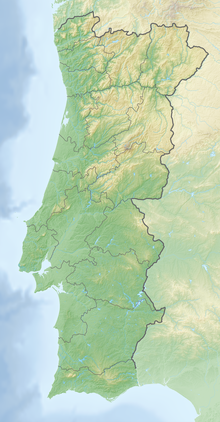Anta da Nave do Grou
Location of the Anta da Nave do Grou in Portugal. |
The Anta da Nave do Grou , also called Anta do Sobral , is a megalithic complex about 3.5 km southwest of Castelo de Vide , in the municipality ( Portuguese Freguesia ) São João Baptista in the district ( Portuguese Concelho ) Castelo de Vide , Portalegre district in the northeast Alentejo .
Anta , Mámoa , Dolmen , Orca and Lapa are the common names in Portugal for the approximately 5000 megalithic structures that were built during the Neolithic in the west of the Iberian Peninsula by the successors of the Cardial or Imprint culture .
Monument preservation
From 1867–1868 the complex was examined and published by Pereira da Costa and in 1910 it was registered and protected as a Monumento Nacional . A modern archaeological follow-up investigation of the site is still pending. In the course of prospecting in 1986 and 2010, the facility was cataloged and documented photographically.
Although no extensive security measures have been carried out so far, the Anta is one of the better preserved megalithic systems in the region. It is privately owned, but open to the public.
Finding
The irregular polygonal burial chamber is wider than it is high (about 3.20 × 2.40 m in plan and 1.80 m high) and is formed by seven granite bearing stones ( orthostats ) . The slightly conical bearing stones are all still preserved in situ . The capstone, which fell during the excavation at the end of the 19th century, was placed back on the burial chamber in 1992.
The former overhang ( Mámoa ) of the grave with a diameter of approx. 25 m is hardly noticeable in the area today. The excavation revealed no evidence of a corridor .
Finds
In the course of the excavation only a stone ax and a clay spoon were recovered.
The site can therefore only be dated generally to the period from the end of the Neolithic to the Copper Age (3500–2000 BC).
Individual evidence
- ↑ a b c d Rosário Gordalina: Anta da Nave do Grou / Anta do Sobral . Direção – Geral do Património Cultural - Sistema de Informação para o Património Arquitectónico, 1991, accessed on December 23, 2019 (Portuguese).
- ↑ a b c Archaeological guide through Portugal . In: Thomas G. Schattner (Ed.): Cultural history of the ancient world . tape 74 . Philipp von Zabern, Mainz 1998, ISBN 3-8053-2313-1 , p. 114 f .
- ↑ Francisco A. Pereira da Costa: Noções sobre o estado préhistórico da terra e do homem seguidas da descripção de alguns dolmins ou antas de Portugal . Lisbon 1868, p. 90 (Portuguese).
- ↑ Decreto de 16-06-1910. (PDF) In: DG, n.º 136, de 23-06-1910. June 23, 1910, p. 2163 , accessed December 23, 2019 (Portuguese).
- ↑ a b c A. Martins: Anta da Nave do Grou . Direção – Geral do Património Cultural, accessed December 23, 2019 (Portuguese).
- ↑ a b c Anta da Nave do Grou / Sobral . Direção – Geral do Património Cultural - Portal do Arqueólogo, accessed on December 23, 2019 (Portuguese).
literature
- A. Martins: Anta da Nave do Grou . Direção-Geral do Património Cultural, accessed on July 11, 2018 (Portuguese, with extensive literature sv Bibliografia).
- Thomas G. Schattner (Ed.): Archaeological guide through Portugal (= cultural history of the ancient world . Vol. 74). Philipp von Zabern, Mainz 1998, ISBN 3-8053-2313-1 p. 114
Web links
- Anta do Sobral. Retrieved December 23, 2019 .
Coordinates: 39 ° 24 ′ 0.8 ″ N , 7 ° 29 ′ 26.6 ″ W.
